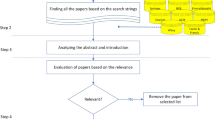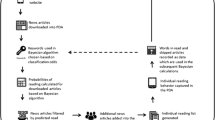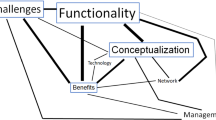Abstract
Nowadays, end users are surrounded by plenty of services that are somehow supporting their daily routines and activities. Involving end users into the process of service creation can allow end users to benefit from a cheaper, faster, and better service provisioning. Even though we can already find tools that face this challenge, they consider end users as isolate individuals. In this paper, we investigate how social networks can be used to improve the composition of services by end users. To do so, we propose a graph-based definition of a social structure, and analyse how social connections can be exploited to both facilitate end users to discover services through browsing these connections, and recommend services to end users during the composition activity. As proof of concept, we implement and evaluate the proposed social network in the context of EUCalipTool, a mobile end-user environment for composing services.










Similar content being viewed by others
References
Yu J, Sheng QZ, Han J, Wu Y, Liu C (2012) A semantically enhanced service repository for user-centric service discovery and management. Data Knowl Eng 72:202–218
Daniel F, Casati F, Benatallah B, Shan M-C (2009) Hosted universal composition: models, languages and infrastructure in mashart. In: International conference on conceptual modeling. Springer, pp 428–443
Danado J, Paternò F (2014) Puzzle: a mobile application development environment using a jigsaw metaphor. J Vis Lang Comput 25(4):297–315
Aghaee S, Pautasso C (2014) End-user development of mashups with naturalmash. J Vis Lang Comput 25(4):414–432
Valderas P, Torres V, Mansanet I, Pelechano V (2017) A mobile-based solution for supporting end-users in the composition of services. Multimed Tools Appl 76(15):16315–16345
Al-Masri E, Mahmoud QH (2007) Wsce: a crawler engine for large-scale discovery of web services. In: IEEE international conference on web services (ICWS 2007). IEEE, pp 1104–1111
Santanche A, Nath S, Liu J, Priyantha B, Zhao F (2006) Senseweb: browsing the physical world in real time. Demo Abstract, ACM/IEEE IPSN06. Nashville, TN, pp 1–2
Nielsen J (2015) Tops of 2015: digital, media and entertainment. http://www.nielsen.com/us/en/insights/news/2015/tops-of-2015-digital.html, 2015. Accessed Jan 2019
IFTTT, If this then that. https://ifttt.com/, 2015. Accessed Jan 2019
Dlvr.it, Social media auto posting & scheduling tool. https://dlvrit.com/, 2018. Accessed: Jan 2020
Zapier, Connect your apps and automate workflows. https://zapier.com/, 2018. Accessed Jan 2019
Node-RED, Flow-based programming for the internet of things. https://nodered.org/, 2017. Accessed Jan 2019
Maaradji A, Hacid H, Daigremont J, Crespi N (2010) Towards a social network based approach for services composition. In: 2010 IEEE international conference on communications. IEEE, pp 1–5
Soriano J, Lizcano D, Hierro JJ, Reyes M, Schroth C, Janner T (2008) Enhancing user-service interaction through a global user-centric approach to SOA. In: 4th international conference on networking and services (ICNS 2008). IEEE, pp 194–203
Jiang P, Ding K, Leng J (2016) Towards a cyber-physical-social-connected and service-oriented manufacturing paradigm: social manufacturing. Manuf Lett 7:15–21
Tamburri DA, Lago P, Vliet Hv (2013) Service networks for development communities. In: Proceedings of the 2013 international conference on software engineering. IEEE Press, pp 1253–1256
Maamar Z, Wives LK, Badr Y, Elnaffar S (2009) Even web services can socialize: a new service-oriented social networking model. In: 2009 international conference on intelligent networking and collaborative systems. IEEE, pp 24–30
Yu S, Woodard CJ (2008) Innovation in the programmable web: characterizing the mashup ecosystem. In International conference on service-oriented computing. Springer, pp 136–147
Chen W, Paik I, Hung PC (2013) Constructing a global social service network for better quality of web service discovery. IEEE Trans Serv Comput 8(2):284–298
Ren M, Ren L, Jain H (2018) Manufacturing service composition model based on synergy effect: a social network analysis approach. Appl Soft Comput 70:288–300
Kranz M, Roalter L, Michahelles F (2010) Things that twitter: social networks and the internet of things. In: What can the internet of things do for the citizen (CIoT) workshop at the 8th international conference on pervasive computing (Pervasive 2010), pp 1–10
Bleecker J (2006) A manifesto for networked objects—cohabiting with pigeons, ARPHIDS and AIBOS in the internet of things. In: Proceedings of the 13th international conference on human–computer interaction with mobile devices and services, MobileHCI, pp 1–17
Atzori L, Iera A, Morabito G (2011) Siot: giving a social structure to the internet of things. IEEE Commun Lett 15(11):1193–1195
Guinard D, Fischer M, Trifa V (2010) Sharing using social networks in a composable web of things. In: PerCom workshops, pp 702–707
Meissa M, Benharzallah S, Kahloul L (2017) Service composition based on the social relations in the internet of things. In: The 18th international Arab conference on information technology (ACIT’2017)
Wang S, Zhou A, Yang M, Sun L, Hsu C-H, Yang F (2017) Service composition in cyber-physical-social systems. IEEE Transactions on Emerging Topics in Computing. IEEE, pp 1–1. https://doi.org/10.1109/TETC.2017.2675479
Reuter C, Kaufhold M-A, Ludwig T (2017) End-user development and social big data–towards tailorable situation assessment with social media. In: New perspectives in end-user development. Springer, pp 307–332
Massa D, Spano L (2016) Facemashup: an end-user development tool for social network data. Future Internet 8(2):10
Boyd DM, Ellison NB (2007) Social network sites: definition, history, and scholarship. J Comput Mediat Commun 13(1):210–230
Hung PC, Li H, Jeng J-J (2004) Ws-negotiation: an overview of research issues. In: Proceedings of the 37th annual Hawaii international conference on system sciences, 2004. IEEE, p 10
Ding Z, Xiao L, Hu J (2008) Performance analysis of service composition using ordinary differential equations. In 2008 12th IEEE international workshop on future trends of distributed computing systems. IEEE, pp 30–36
Milanovic N, Malek M (2004) Current solutions for web service composition. IEEE Internet Comput 8(6):51–59
Lieberman H, Paternò F, Klann M, Wulf V (2006) End-user development: an emerging paradigm. In: End user development. Springer, pp 1–8
Segal J (2005) Two principles of end-user software engineering research. ACM SIGSOFT Softw Eng Not 30(4):1–5
Workflow.is, Workflow. spend less taps, get more done. https://workflow.is/, 2018. Accessed Jan 2019
Dey AK (2001) Understanding and using context. Pers Ubiquit Comput 5(1):4–7
Steinbock D (2005) The mobile revolution: the making of mobile services worldwide. Kogan Page Publishers, London
Snoonian D (2003) Smart buildings. IEEE Spectr 40(8):18–23
Milicevic AK, Nanopoulos A, Ivanovic M (2010) Social tagging in recommender systems: a survey of the state-of-the-art and possible extensions. Artif Intell Rev 33(3):187–209
Ermagan V, Krüger IH (2007) A UML2 profile for service modeling. In: International conference on model driven engineering languages and systems. Springer, pp 360–374
Amir R, Zeid A (2004) A UML profile for service oriented architectures. In: Companion to the 19th annual ACM SIGPLAN conference on object-oriented programming systems, languages, and applications. ACM, pp 192–193
Paolucci M, Kawamura T, Payne TR, Sycara K (2002) Semantic matching of web services capabilities. In: The semantic web—ISWC 2002, (Berlin, Heidelberg). Springer, Berlin, pp 333–347
Klusch M, Sycara K (2001) Brokering and matchmaking for coordination of agent societies: a survey. In: Coordination of internet agents. Springer, pp 197–224
Wellman B, Berkowitz SD (1988) Social structures: a network approach. CUP Archive
Ehrig H, Mahr B (2012) Fundamentals of algebraic specification 1: equations and initial semantics, vol 6. Springer, Berlin
de Lara J, Bardohl R, Ehrig H, Ehrig K, Prange U, Taentzer G (2007) Attributed graph transformation with node type inheritance. Theor Comput Sci 376(3):139–163
Valderas P, Torres V, Pelechano V (2019) A graph-based definition of a social network for the composition of services by end-users. Technical report pros-tr-2019-01. tech rep, Universitat Politècnica de València. Accessed Oct 2019
Valderas P, Torres V, Pelechano V (2019) Towards the composition of services by end-users. In: Business & information systems engineering, pp 1–17
Benedek J, Miner T (2002) Measuring desirability: new methods for evaluating desirability in a usability lab setting. Proc Usability Prof Assoc 2003(8–12):57
Smith C (2018) Interesting IFTTT statistics and facts. https://expandedramblings.com/index.php/ifttt-statistics-and-facts/. Accessed Oct 2019
Ryan M (2016). The average twitter user now has 707 followers. https://kickfactory.com/blog/average-twitter-followers-updated-2016/. Accessed Jan 2020
Segal J (2003) The nature of evidence in empirical software engineering. In: 11th annual international workshop on software technology and engineering practice. IEEE, pp 40–47
Burnett M, Cook C, Rothermel G (2004) End-user software engineering. Commun ACM 47(9):53–58
Schuler D, Namioka A (1993) Participatory design: principles and practices. CRC Press, Boca Raton
Fischer G, Giaccardi E, Ye Y, Sutcliffe AG, Mehandjiev N (2004) Meta-design: a manifesto for end-user development. Commun ACM 47(9):33–37
Bouvin NO (1999) Unifying strategies for web augmentation. In: Proceedings of the 10th ACM conference on hypertext and hypermedia: returning to our diverse roots: returning to our diverse roots. Citeseer, pp 91–100
Firmenich D, Firmenich S, Rivero JM, Antonelli L, Rossi G (2018) Crowdmock: an approach for defining and evolving web augmentation requirements. Requir Eng 23(1):33–61
Gil M, Serral E, Valderas P, Pelechano V (2013) Designing for user attention: a method for supporting unobtrusive routine tasks. Sci Comput Program 78(10):1987–2008
Acknowledgements
This work has been developed with the financial support of the Spanish State Research Agency under the Project TIN2017-84094-R and co-financed with ERDF.
Author information
Authors and Affiliations
Corresponding author
Additional information
Publisher's Note
Springer Nature remains neutral with regard to jurisdictional claims in published maps and institutional affiliations.
Rights and permissions
About this article
Cite this article
Valderas, P., Torres, V. & Pelechano, V. A social network for supporting end users in the composition of services: definition and proof of concept. Computing 102, 1909–1940 (2020). https://doi.org/10.1007/s00607-020-00796-8
Received:
Accepted:
Published:
Issue Date:
DOI: https://doi.org/10.1007/s00607-020-00796-8




